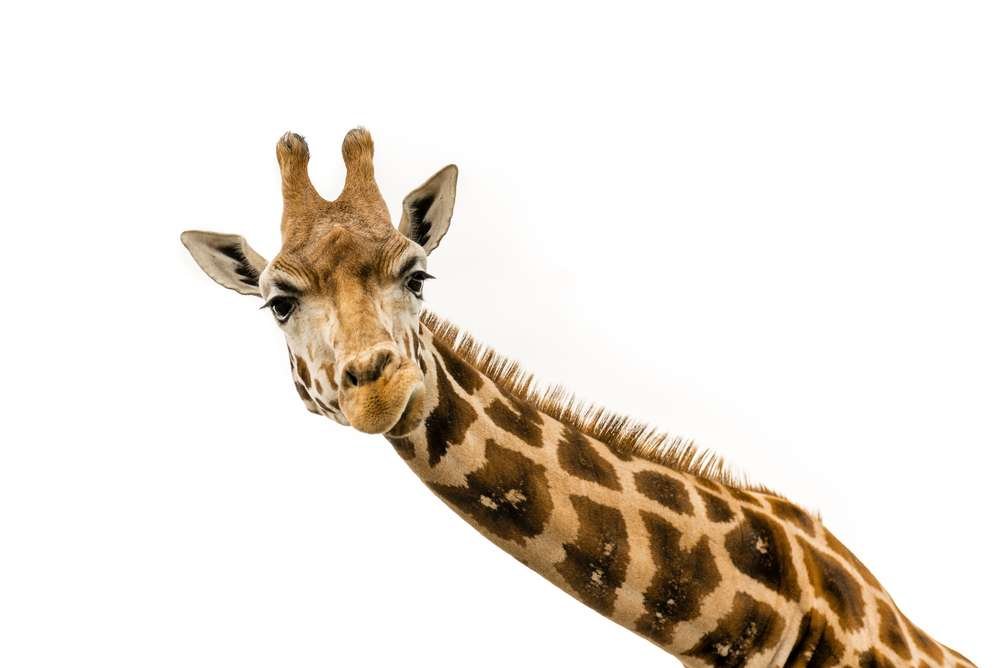Angolan Giraffe
( ndyabuluba or nyamalikiti )
- Giraffa camelopardalis angolensis or Giraffa giraffa angolensis
- IUCN Status: Vulnerable
- Trend: decreasing

- Kingdom: Animalia
- Phylum: Chordata
- Class: Mammalia
- Order: Artiodactyla
- Family: Giraffidae
- Genus: Giraffa
Share:
General Information
Giraffe are the world’s tallest animal. The name ‘giraffe’ comes from the Latin word ‘camelopardalis’, meaning ‘camel marked like a leopard’. Zambia is home to three types of Giraffe. Namely the Angolan Giraffe (Giraffa g. angolensis), the smaller Masai giraffe (Giraffa tippelskirchiin) and luangwa/thornicroft’s giraffe. The best places to see them in the wild are in the South Luangwa is home to the Masai Giraffes and the Mosi-au-Tunya, Sioma Ngwezi and Lusaka National Parks which are home to Angolan Giraffes.
Giraffe have a long muzzle, large eyes and two bony horns called ‘ossicones’. They are one of the few animals that are born with horns which lie flat and are not attached to the skull to avoid injury at birth, fusing with their skull as they get older. These horns are thin and tufted in females and thicker and bald on top in males as they wear during fights. Male also develop calcium deposits on top of their heads as they age which help to deliver heavier blows when fighting rival males.
Their long, black tongues can extend more than 45 cm and are used to grasp onto leaves. They also have two or three unique lobed canine teeth with are used like a comb to strip leaves from branches.
Although giraffe’s bones are much larger and are linked by ball and socket joints so they are very flexible. Giraffe have good eyesight, hearing and smell.
Fun Facts!
Description
- Shoulder height: 3.3 meters
- Length: males up to 5.5 metres and females up to 4.5 metres
- Weight: 700 – 1,100 kg
- Lifespan: 15 – 20 years
Ecology and Behaviour
Giraffe spend up to 75% of their day eating. They are browsers and eat a variety of leaves, herbs, flowers and fruit. Acacia leaves form the bulk of their diet, but they do eat over 30 kbs a day, from 100 different plant species. They only need to drink every two or three days as they take in most of the moisture they need from leaves. They sleep for short periods of up to two hours at night, similar to elephants.
Giraffe are quiet animals, making a variety of noises: mothers bellow to their young, males emit coughs during courtship and calves snort, bleat and mew. They snore, hiss, grunt and make flute-like sounds and are thought to communicate over long distances using infra-sound, humming at night to each other.
Male giraffe perform a ritualised sparring called ‘necking’ to test their strength which determines hierarchical status. Contestants swing their necks at each other, striking body blows with their head – arching their necks and taking it in turn to try and hit their opponent. They then ‘square off’ against each other, tail to tail whilst entwining their necks. ‘Necking’ by young males can last for some time, as they pause standing motionless, or nibble on leaves, before continuing their duel. The winner often lifts his nose in the air trying to make himself look taller than his opponent. A serious fight between a dominant bull and a unknown adult male is often brief and very violent. Their heavy heads and long necks can deliver staggering blows. Usually the loser will walk away after a short duel, but winners have been known to knock their opponent unconscious!
Lion, leopard, African wild dog and hyenas prey on young giraffe, with only 25 – 50% reaching maturity.
Conservation
The Angolan Giraffe are increasing in number while the Masai Giraffe’s are stable. They are both classified as vulnerable on the IUCN Red list.
Distribution and Habitat
Giraffe are social mammals that live in groups, called ‘towers’ or ‘journeys’. These contain up to 20 individuals, mainly mothers with their young, who do not form strong social ties. Males are less social, forming bachelor herds with no permanent members. They are not territorial and have variable home ranges, from 5 to 650 sq kms.
Giraffe live on savanna, preferring semi-arid open acacia woodlands with scattered trees and bushes. They have a distinctive gait and can run 10 km per hour for long stretches, reaching 50 km per hour for short bursts.
A female giraffe gives birth to a single calf, rarely twins, after a gestation period of 15 months. They give birth standing up and the new-born calf drops two metres to the ground. Baby giraffe are able to stand after 20 minutes and are 1.8 metres tall. They are closely guarded by their mothers for the first few weeks and then play with other young giraffe in ‘crèches’. They are weaned at 13 months.
Interaction with humans
Human threats towards giraffe include habitat loss and poaching for their meat, skin and tails.
No donation to this project yet.
| M | T | W | T | F | S | S |
|---|---|---|---|---|---|---|
| 1 | 2 | 3 | 4 | 5 | 6 | 7 |
| 8 | 9 | 10 | 11 | 12 | 13 | 14 |
| 15 | 16 | 17 | 18 | 19 | 20 | 21 |
| 22 | 23 | 24 | 25 | 26 | 27 | 28 |
| 29 | 30 | 31 | ||||


